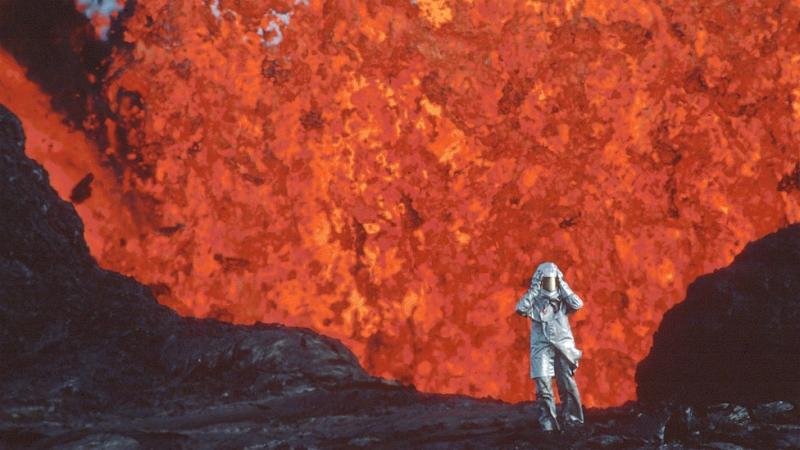The Most Moving Film of the Year Is a Documentary About Volcanoes


Fire of Love , a documentary about two volcanologists, begins on a tundra. They’re en route to yet another volcano but there’s no boiling lava in sight, no steaming geysers—just mounds of icy slush and wind-sculpted snowdrifts making the trek as challenging as possible.
Yet that’s the charm of Fire of Love : Even without a volcano onscreen, the boldness of the two tiny humans at its center is striking enough. The film, rolling out in select theaters this month , follows Maurice and Katia Krafft, a married French couple who spent the 1970s and ’80s studying, as the movie puts it, “how the Earth’s heart beats.” The film draws from about 200 hours of breathtaking expedition footage the Kraffts accumulated, books and journal entries they wrote, and interviews they gave. Narrated by the filmmaker and actor Miranda July, Fire of Love offers a bonanza of stunning images and fascinating insight into the workings of volcanoes, tracing how the Kraffts gathered their findings through meticulous research and hands-on analysis.
But Fire of Love is as much a tragedy as it is a marvel. In its opening minutes, July’s ruminative voice-over warns the viewer of the Kraffts’ eventual deaths at the base of Japan’s Mount Unzen in 1991, casting a melancholic pall over the narrative to come. Maurice and Katia’s courtship is depicted through whimsical yet wistful animated sequences; the unusual approach matches their unusual, even mystical, relationship as two people who seemed destined to live and die together. Throughout Fire of Love , the director Sara Dosa regards the Kraffts with both reverence and trepidation, translating their tale into a singular fable about doomed love and the allure of the unknown. The result is more than a mere nature documentary. It is one of the most moving and mesmerizing films of the year, a meditation on the wonders of nature and human curiosity.
After all, the Kraffts left behind a treasure trove of footage that captured their personalities. The pair had a knack for stylish shooting. Maurice was the videographer, tracking movement and scale with French New Wave whip zooms; Katia, the photographer, took precise pictures of the smallest details. The editing transforms these artifacts into a ravishing collage, while the film’s rollicking score makes even a shot of a boulder tumbling down a hill feel climactic. By treating the Kraffts’ cache of images as cinema, Fire of Love gives the audience a chance to see volcanoes the way the couple did: as works of art.
The Kraffts also had a mischievous flair for the dramatic. They often posed before walls of fire, beside rivers of lava, or on the lips of volcanoes, as if daring the viewer to reach into the screen and pull them back from the edge of the apparent abyss. July’s raspy narration is just as cheeky; she sometimes sounds like she’s responding to Katia and Maurice directly, gently teasing them for how affectionate they are toward their scorching subjects. Fire of Love skillfully weaves these eccentric flourishes into its thoughtful examination of the Kraffts’ devotion to volcanoes. It plays up the otherworldliness of the images they captured, juxtaposing them against the couple’s deeply human desire to understand what they love.
As the film goes on, it subtly shifts from a playful legend of two quirky scientists to a more somber, philosophical contemplation of their shared love. The volcanoes were apathetic toward the Kraffts, of course, yet the Kraffts became more audacious in their quest to solve the mysteries they held. They stopped studying milder red volcanoes, running toward gray volcanoes—ones that erupt in plumes of ash and smoke that often kill humans—instead. “It will kill me one day,” Maurice says in an interview, “but that doesn’t bother me at all.” The film seems to endorse his confidence, applying his voice-over often onto gorgeous shots of flowing lava.
But it also lingers on the duo’s last moments, tracing the way they got closer and closer to Mount Unzen, seeking a better view, a better angle of the explosion they knew was coming. Were they fearless, or had they become too enamored of volcanos to fully consider the danger of their job? What kept them going on their noble search for comprehension, when they knew it would probably end their lives? The film doesn’t deign to offer answers. But it still understands that there was something magical and haunting about the way the Kraffts chose to live—and by extension, to die.
I’ve seen Fire of Love multiple times now, and each viewing has yielded a detail I’d missed. Late in the film, for instance, I caught a glimpse of bandages on Katia’s left leg that I definitely didn’t notice during my first watch at Sundance. The shot plays for barely a second. Yet it made me wonder how she got the injury, whether it was a souvenir from an expedition, a foreshadowing of the danger to come. It inspired a fresh curiosity, even an appetite for another rewatch. Perhaps this same desire to observe and understand as much as possible was what drove the Kraffts to trek up volcanoes again and again—the experience made new each time, no matter how many climbs had come before.

Love will take you to places where apathy fears to tread.